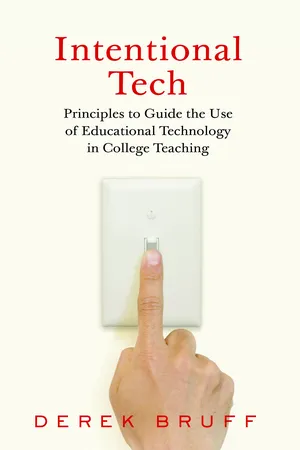
Intentional Tech
Principles to Guide the Use of Educational Technology in College Teaching
- 216 pages
- English
- ePUB (mobile friendly)
- Available on iOS & Android
Intentional Tech
Principles to Guide the Use of Educational Technology in College Teaching
About this book
Chalkboards and projectors are familiar tools for most college faculty, but when new technologies become available, instructors aren't always sure how to integrate them into their teaching in meaningful ways. For faculty interested in supporting student learning, determining what's possible and what's useful can be challenging in the changing landscape of technology.
Arguing that teaching and learning goals should drive instructors' technology use, not the other way around, Intentional Tech explores seven research-based principles for matching technology to pedagogy. Through stories of instructors who creatively and effectively use educational technology, author Derek Bruff approaches technology not by asking "How to?" but by posing a more fundamental question: "Why?"
Frequently asked questions
- Essential is ideal for learners and professionals who enjoy exploring a wide range of subjects. Access the Essential Library with 800,000+ trusted titles and best-sellers across business, personal growth, and the humanities. Includes unlimited reading time and Standard Read Aloud voice.
- Complete: Perfect for advanced learners and researchers needing full, unrestricted access. Unlock 1.4M+ books across hundreds of subjects, including academic and specialized titles. The Complete Plan also includes advanced features like Premium Read Aloud and Research Assistant.
Please note we cannot support devices running on iOS 13 and Android 7 or earlier. Learn more about using the app.
Information
Table of contents
- Cover Page
- Title Page
- Copyright Page
- Contents
- Acknowledgments
- Introduction
- 1. Times for Telling
- 2. Practice and Feedback
- 3. Thin Slices of Learning
- 4. Knowledge Organizations
- 5. Multimodal Assignments
- 6. Learning Communities
- 7. Authentic Audiences
- Conclusion
- Notes
- References
- Index